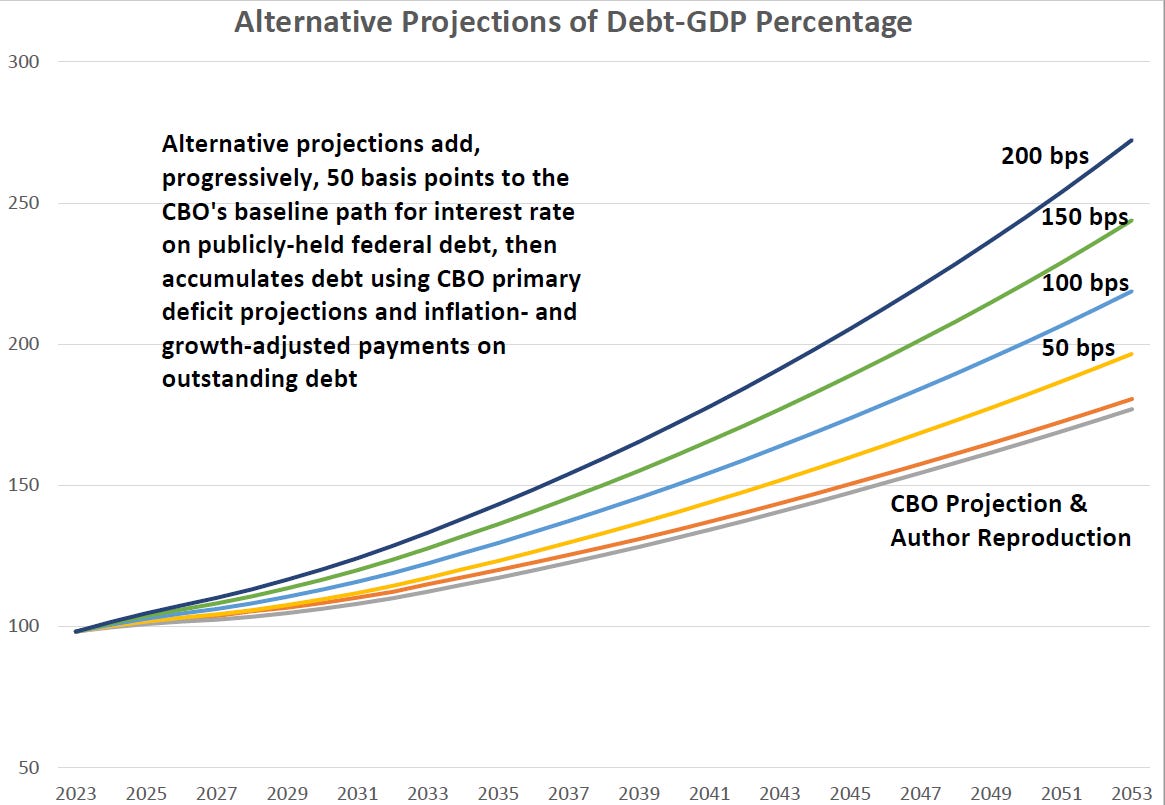Questions on National Debt and Interest Rates
Going a little out of our normal lane, but an interesting an important question nonetheless.
At yesterday’s House Financial Services Committee FSOC hearing, several members of the Committee asked Secretary Yellen for her thoughts on the ever-growing federal debt. Particularly intriguing was Rep. Steil’s questions about Treasury’s internal forecasts for future debt levels under a higher interest rate environment. Secretary Yellen didn’t have “a number…at [her fingertips],” but she did highlight OMB’s role in modeling future debt levels as part of the annual President’s Budget process.
These debt forecasts—however imperfect they may be (and more on that below)—are essential information for policymakers to have at hand when debating matters that could impact the financial system and the economy writ large. Since the FY 2025 President’s Budget is about a month away from being released, it is interesting to take a look at existing government debt projections and see how current and realistic they are.
Taking a look at OMB’s FY 2024 Analytical Perspectives, the Administration assumes that interest rates on the federal debt (as proxied by 10 -Year Treasury Notes) will slowly decrease until 2026 where they stabilize at 3.4 percent through 2048.[1] OMB continues to estimate in its baseline projection that federal debt “plateaus” at 131.2 percent of GDP in 2048.[2] This is, by all accounts, an extraordinarily optimistic projection.
Similarly, the Congressional Budget Office’s Long-Term Budget Outlook (released 2/7/24) assumes the average interest rate on federal debt to range from 3.3 to 3.5 percent over the next 10 years.[3] When combined with CBO’s continuation of current policies assumption, they predict the debt hitting 172 percent of GDP by 2054. CBO goes on to predict that (again under a continuation of current policies scenario) net interest payments on the debt almost doubles from today’s level of 3.1 percent of GDP to 5.8 percent of GDP between 2045 and 2054.
But does it make sense to assume interest levels on the debt will hover around 3.5 percent for the indefinite future? What would happen if interest rates stabilized around 6.0 percent (or even higher) like they did in much of the 1990s? OMB claims that any increase above their projections is unlikely because “over the last two decades, interest rate projections have been, on average, too high.[4]” This may be correct as a matter of history, but it also ignores the possibility that future federal debt markets may be materially different than pre-COVID 21st Century debt markets. As such, it makes sense to at least ask the question, ‘what happens if average interest on the debt continues to increase?’
I asked our friend and visiting Mercatus scholar Eric Leeper to do some back of the envelope projections of how different interest rate assumptions would change federal debt projections. Eric begrudgingly accepted the task but was quick to remind me that 1.) this is a quick and dirty exercise and should not be taken as gospel; and 2.) these types of long-term projections are notoriously flawed and particularly so when you assume a static continuation in current policies like OMB and CBO do. Such a framework means that “by construction, there is no feedback from fiscal outcomes to economic variables.” (Side note, Eric has written a very interesting post on this topic that can be found here).
That said, Eric took the most recent public CBO data and reversed engineered a pretty close approximation of their long-term debt projections. He then increased the interest rate assumptions progressively by 50 basis points to produce the chart below. As you can see, the results are a little less optimistic…
All else being equal, a 2.0 percent increase in average interest rates means that the debt reaches 150 percent of GDP by ~2035 and 200 percent by 2043. Such unprecedented levels would almost certainly have some sort of impact on debt markets and the broader economy.
Is it certain that this is our future? I have no idea. But what does seem clear is that policy makers should be taking these less rosy possibilities into account, lest they be caught flat footed. Hopefully we see a greater discussion of government debt projections (and their utility or lack thereof) going forward.
[1] https://www.whitehouse.gov/wp-content/uploads/2023/03/spec_fy2024.pdf Page 24
[2] https://www.whitehouse.gov/wp-content/uploads/2023/03/spec_fy2024.pdf Page 20
[3] https://www.cbo.gov/system/files/2024-02/59710-Outlook-2024.pdf Table 1-3
[4] https://www.whitehouse.gov/wp-content/uploads/2023/03/spec_fy2024.pdf page 24


